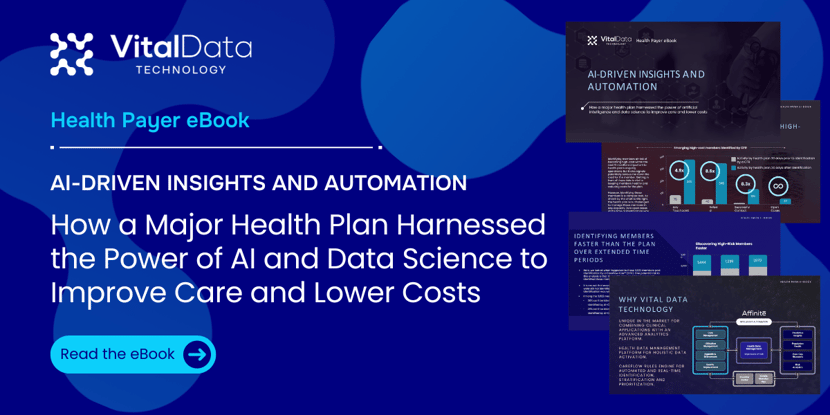
“The future is already here - it’s just unevenly distributed.” William Gibson’s famous line could have been written about healthcare. Across the payer landscape, a few forward-looking health plans are harnessing data, automation, and advanced analytics to fundamentally rewire care management - while many are still relying on static lists and manual workflows.
The future of care management specifically is being shaped by transformative forces: increasingly complex member populations, data proliferation, and heightened pressure for operational efficiency and measurable outcomes. In this rapidly changing landscape, payer care management teams require more than incremental improvements - they need solutions that reimagine how member identification, engagement, and intervention are driven at scale.
This blog explores six foundational features essential for any next-generation care management platform aiming to meet these demands, and why they matter for health plans looking to generate lasting clinical and financial impact.
1. Complete Data Activation
Imagine trying to treat a patient while only seeing half their chart. That’s how traditional care management operates. To create real value, payers must activate all available data sources, including medical claims, EMRs, pharmacy, lab results, and social determinants of health (SDoH).
Consider this: research from the Kaiser Family Foundation shows that up to 50% of health outcomes are driven by social and behavioral factors such as housing, food security, and transportation. Without integrating these insights, risk models remain blind to critical drivers of member outcomes.
A holistic, multi-dimensional data strategy not only sharpens risk assessment but enables more precise, individualized interventions - like proactively connecting a high-risk diabetic patient to nutrition services before hospitalization becomes inevitable.
2. Unique Automation Logic
Manual processes aren’t just inefficient, they’re dangerous in a system where time is health. A National Academy of Medicine report found that avoidable delays in care contribute significantly to adverse outcomes.
This is where intelligent automation shifts the paradigm. Next-generation platforms continuously monitor member data, detect subtle signals of rising risk, and trigger proactive recommendations for care managers. It’s the difference between waiting for a claim to surface six weeks after an ER visit versus intervening in real-time when pharmacy fills and vitals suggest worsening heart failure.
Automation is not about replacing human judgment—it’s about amplifying it, ensuring clinicians spend less time sorting spreadsheets and more time engaging members at their moment of need.
3. Embedded Risk Intelligence
Advanced care management must be built on embedded analytics, not bolted-on reports. Risk algorithms, machine learning, and predictive models need to run beneath the surface - driving decisions in real time.
For example, NCQA research highlights how advanced risk stratification improves quality measure performance, enabling plans to meet HEDIS and Stars benchmarks while targeting resources more effectively.
Think of it as shifting from a rearview mirror approach - analyzing what already happened - to a windshield view, where plans can anticipate member needs and intervene earlier.

4. Advanced Rules Engine for Workflow Automation
Ask any care manager and they’ll tell you: repetitive manual tasks are a silent epidemic of burnout. Studies in Health Affairs show that administrative burden consumes nearly one-sixth of U.S. healthcare spending.
A next-gen rules engine is more than a technical feature - it’s an antidote to this inefficiency. By automatically routing next-best actions based on real-time risk signals, platforms free clinical teams to operate at the top of their license. For example, when a patient’s lab result indicates deteriorating kidney function, the system can immediately assign the case to the right specialist nurse, cutting hours or days from response time.
5. Member and Provider Engagement
Care management fails if it stops at the payer’s walls. True transformation requires bidirectional connectivity with both members and providers. Mobile apps, portals, and secure messaging tools aren’t optional add-ons - they’re table stakes for real-time coordination.
Picture a provider receiving an automated alert about a patient’s new behavioral health risk while the care manager simultaneously reaches out to the member via mobile app. The result is synchronized engagement across the ecosystem, fostering trust, reducing duplication, and improving satisfaction on all sides.
6. 360-Degree Member Views
Fragmentation is the enemy of effective care. Advanced platforms deliver a single, integrated member profile that unites clinical data, utilization history, predicted risks, SDoH factors, and even likely future costs.
For executives, the value is clear: in a single glance, teams can identify not just who is at risk but why, and what to do next. This transforms decision-making from reactive guesswork into real-time, data-driven precision.
Putting It All Together: A Model for Modernization
These six pillars aren’t theoretical - they’re real, they’re measurable, and they’re achievable. But only if platforms are designed to deliver them in concert.
That’s why Affinitē Care Management from Vital Data Technology is so powerful. By uniting deep data integration, intelligent automation, embedded risk analytics, and seamless engagement features, Affinitē sets a new bar for what care management can and should be. Its AI-driven CareFlow™ Rules engine doesn’t just recommend next-best actions - it embeds them directly into workflows, empowering teams to engage faster, intervene smarter, and drive measurable ROI.
To see how Affinitē Care Management can equip your team for performance, efficiency, and value-based outcomes, schedule a demo today.




